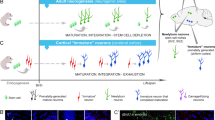Abstract
issociated dorsal root ganglion cells from human fetuses were exposed to 2,5-hexanedione (2,5-HD) for 2 weeks. Morphological changes induced by 2,5-HD consisted in focal neurofilament (NF)-containing enlargements preferentially located in distal, preterminal regions of unmyelinated fibers. Tangles of NF were also observed in the perikarya of nerve cells. Morphometric analysis disclosed that the cross-sectional areas of the 2,5-HD treated axons were 30% smaller than those of control axons. This alteration was associated with reduction of number of NF per unit area. These findings demonstrate that 2,5-HD treatment induces a generalized disorganization of neuronal and axonal NF responsible for focal enlargements as well as atrophic changes of unmyelinated fibers.
Similar content being viewed by others
References
Abou-Donia MB, Makkawy M, Graham DG (1982) The relative neurotoxicities of n-hexane, methyl n-butyl ketone, 2,5-hexanediol and 2,5-hexanedione following oral or intraperitoneal administration in hens. Toxicol Appl Pharmacol 82: 369–389
Asbury AK (1979) Neuropathies with filamentous abnormalities. In: Aguayo HA, Karpati G (eds) Current topics in nerve and muscle research. Excerpta Medica, Amsterdam, pp 243–254
Asbury AK, Brown MJ (1980) The evolution of structural changes in distal axonopathies. In: Spencer PS, Schaumburg HH (eds) Experimental and clinical Neurotoxicology. Williams & Wilkins, Baltimore, pp 179–192
De Caprio AP, O'Neill EA (1985) Alterations in rat axonal cytoskeletal proteins induced by in vitro and in vivo 2,5-hexanedione exposure. Toxicol Appl Pharmacol 78: 235–247
Durham HD (1988) Aggregation of intermediate filaments by 2,5-hexanedione: comparison of effects on neurofilaments, GFAP-filaments and vimentin-filaments in dissociated cultures of mouse spinal cord-dorsal root ganglia. J Neuropathol Exp Neurol 47: 432–442
Durham HD, Peña SDJ, Carpenter S (1983) The neurotoxins 2,5-hexanedione and acrylamide promote aggregation of intermediate filaments in cultured fibroblasts. Muscle Nerve 6: 631–637
Durham HD, Peña SDJ, Ecobichon DJ (1988) Hexaydrocarbon effects on intermediate filament organization in human fibroblasts. Muscle Nerve 11: 160–165
Faundez V, Alvarez J (1986) Microtubules and caliber in developing axons. J Comp Neurol 250: 73–80
Friede RL, Samorajski T (1970) Axon caliber related to neurofilaments and microtubules in sciatic nerve fibers of rats and mice. Anat Rec 167: 379–388
Graham DG, Anthony DC, Boekelheide K, Maschmann NA, Richards RG, Wolfram JW, Shaw BR (1982) Studies of the molecular pathogenesis of hexane neuropathy. II. Evidence that pyrrole derivatization of lysyl residues leads to protein crosslinking. Toxicol Appl Pharmacol 64: 415–422
Graham DG, Szakal-Quin G, Priest JW, Anthony DC (1984) In vitro evidence that covalent crosslinking of neurofilaments occurs in γ-diketone neuropathy. Proc Natl Acad Sci (USA) 81: 4979–4982
Hoffman PN, Lasek RJ, Griffin JW, Price DL (1983) Slowing of the axonal transport of neurofilament proteins during development. J Neurosci 3: 1694–1700
Jones HB, Cavanagh JB (1983) Cytochemical staining characteristics of peripheral nodes of Ranvier in hexacarbon. J Neurocytol 64: 459–473
Lapadula DM, Suwita E, Abou-Donia M (1988) Evidence for multiple mechanisms responsible for 2,5-hexanedione-induced neuropathy. Brain Res 458: 123–131
Malorni W, Iosi F, Formisano G, Arancia G (1989) Cytoskeletal changes induced in vitro by 2,5-hexanedione: an immunocytochemicala study. Exp Mol Pathol 50: 50–68
Monaco S, Autilio-Gambetti L, Zabel D, Gambetti P (1985) Giant axonal neuropathy: acceleration of neurofilament transport in optic axons. Proc Natl Acad Sci (USA) 82: 920–924
Monaco S, Simonati A, Rizzuto N, Autilio-Gambetti L, Gambetti P (1988) Hexacarbon axonopathy: the morphological expression of altered cytoskeletal translocation. In: Nappi G. et al. (eds) Neurodegenerative disorders: the role played by endotoxins and xenobiotics. Raven Press, New York, pp 239–251
Monaco S, Autilio-Gambetti L, Lasek RJ, Katz MJ, Gambetti P (1989a) Experimental increase of neurofilament transport rate: decrease in neurofilament number and in axon diameter. J Neuropathol Exp Neurol 48: 23–32
Monaco S, Jacob J, Jenich H, Patton A, Autilio-Gambetti L, Gambetti P (1989b) Axonal transport of neurofilament is accelerated in peripheral nerve during 2,5-hexanedione intoxication. Brain Res 491: 328–334
Monaco S, Wongmonkolrit T, Shearson CM, Patton A, Schaetzle B, Autilio-Gambetti L, Gambetti P, Sayre LM (1990) Giant axonopathy characterized by intermediate location of axonal enlargements and acceleration of neurofilament transport. Brain Res 519: 73–81
Peña SDJ (1982) Giant axonal neuropathy: an inborn error of organization of intermediate filaments. Muscle Nerve 5: 166–172
Rizzuto N, Terzian H, Galiazzo-Rizzuto S (1977) Toxic polyneuropathies in Italy due to leather cement poisoning in shoe industries. A light and electron microscopic study. J Neurol Sci 31: 343–354
Sayre LM, Autilio-Gambetti L, Gambetti P (1985) Pathogenesis of experimental giant neurofilamentous axonopathies: a unified hypothesis based on chemical modification to neurofilaments. Brain Res Rev 10: 69–83
Spencer PS, Schaumburg HH (1977a) Ultrastructural studies of the dying- back process. III. The evolution of experimental peripheral giant axonal degeneration. J Neuropathol Exp Neurol 36: 276–299
Spencer PS, Schaumburg HH (1977b) Ultrastructural studies of the dying- back process. IV. Differential vulnerability of PNS and CNS fibers in experimental central-peripheral distal axonopathies. J Neuropathol Exp Neurol 36: 300–320
Veronesi B, Peterson ER, Bornstein MB, Spencer P (1983) Ultrastructural studies of the dying-back process. VI. Examination of nerve fibers undergoing giant axonal degeneration in organotypic culture. J Neuropathol Exp Neurol 42: 153–165
Author information
Authors and Affiliations
Rights and permissions
About this article
Cite this article
Moretto, G., Monaco, S., Passarin, M.G. et al. Cytoskeletal changes induced by 2,5-hexanedione on developing human neurons in vitro. Arch Toxicol 65, 409–413 (1991). https://doi.org/10.1007/BF02284265
Received:
Accepted:
Issue Date:
DOI: https://doi.org/10.1007/BF02284265




